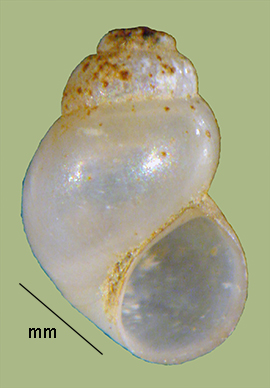> Habitat & Distribution
Hershler (1996) mapped approximately 60 - 80 documented records of P. emarginata, summarizing the range as, "Lotic and lentic inland habitats throughout the Mississippi River basin; drainages of Great Lakes, Hudson Bay, and Mackenzie River to the north." Berry (1943) characterized it as "not common in Michigan, restricted to the Great Lakes and immediate vicinity."
In our study area, populations are most commonly encountered in the Glaciated Central Lowlands extending into the main Ohio River, as well as the northern Great Plains. We have a single record from North Alabama, in Wheeler Reservoir (of the Tennessee River) at a depth of 6 feet. There is also one old record from the James River in eastern Virginia that we have been unable to confirm. Probythinella is peripheral in our study area, FWGNA incidence rank I-3p.
> Ecology & Life History
Binny (1943) generalized that "this species appears to be most abundant at depths of more than 10 feet of water." He reported populations of P. emarginata in Lake St. Clair "only at depths of water greater than 5 feet," and "dredged from Lake Erie at a depth of 18 feet," adding that the little snail seemed to form "the main bulk of the food contents" of whitefish taken from Clear Lake in Manitoba, and Lake Nipigon, Ontario.
Hydrobioid populations seem to be rather nonspecific grazers of small particles (Dillon 2000: 94-97). They are typically dioecious, the males being characterized by a penis that arises from the neck. Females attach single eggs in spare, hemispherical capsules to solid substrates. No specific life history data are as yet available for Probythinella, however.
> Taxonomy & Systematics
Although P. emarginata is widespread and easily-recognizable by virtue of its distinctively blunt shell apex, the taxon has attracted much more than its fair share of systematic confusion and taxonomic churn. The specific nomen was referred to the genera Paludina, Amnicola, Bythinella, Cincinnatia, Hoyia, and Vancleaveia before finally settling in Probythinella in the 1940s. Synonyms include obtusa (Nutting), lacustris (Baker), canadensis (Baker), binneyana (Hannibal) and limafodens (Morrison). Probythinella spent some time erroneously placed in the subfamily Cochliopinae (or Littoridininae), although presently classified among the Nymphophilines in the Hydrobiidae (ss). See Hershler (1996) for a complete anatomical and systematic review, as well as all the gory taxonomic details.
> Maps and Supplementary Resources
- Probythinella distribution in drainages of The Ohio (2019)
- Probythinella in drainages of the Tennessee/Cumberland (2022)
- Hydrobioid distribution in The Great Plains (2024)
> Essays
- Earlier versions of this website, online until August of 2016, adopted the large, broadly-inclusive concept of the Hydrobiidae (sl) following Kabat & Hershler (1993). More recently the FWGNA project has shifted to the Wilke et al. (2013) classification system, distinguishing a much smaller Hydrobiidae (ss) and elevating many hydrobioid taxa previously ranked as subfamilies to the full family level. For more details, see The Classification of the Hydrobioids.
> References
Berry, E. G. (1943) The
Amnicolidae of Michigan: Distribution, ecology, and taxonomy.
Misc. Publ. Mus. Zool. Univ. Mich. 57: 1 - 68.
Dillon, R.T., Jr. (2000)
The Ecology of Freshwater Molluscs. Cambridge
University Press, 509 pp.
Hershler, R. (1996)
Review
of the North American aquatic snail genus Probythinella
(Rissooidea: Hydrobiidae). Invertebrate Biology 115: 120 -
144.
Kabat,
A.R. & R. Hershler (1993)
The prosobranch snail family Hydrobiidae (Gastropoda:
Rissooidea): Review of classification and supraspecific taxa.
Smithsonian Contributions to Zoology 547: 1 - 94.
Morrison, J. P. E. (1947)
Notes on the genus Probythinella
(Hydrobiinae). Nautilus 61: 25 - 28.
Wilke T., Haase M.,
Hershler R., Liu H-P., Misof
B., Ponder W. (2013)
Pushing short DNA
fragments to the limit: Phylogenetic relationships of “hydrobioid”
gastropods
(Caenogastropoda: Rissooidea). Molec.
Phyl. Evol. 66: 715 – 736.
Walker, B.
(1918)
A synopsis of the classification of the fresh-water mollusca
of
North America, North of Mexico. University of Michigan Museum
of
Zoology Misc. Publ. 6: 1 - 213.







